Unit1 what's the matter 导学案 英语人教版 八年级下册
- 格式:doc
- 大小:99.00 KB
- 文档页数:12
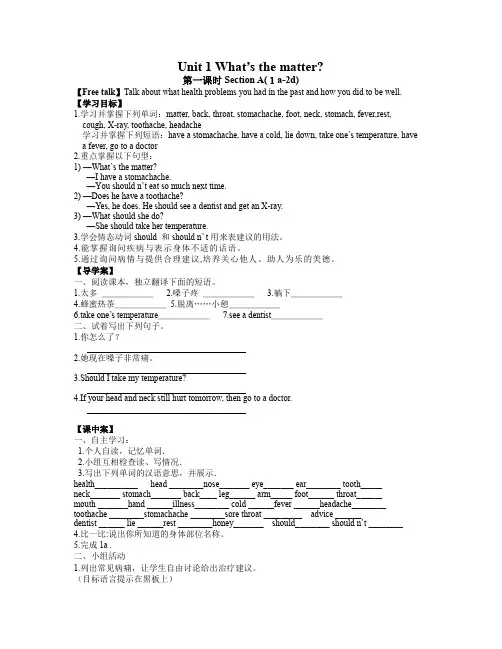
Unit 1 What’s the matter?第一课时Section A(1a-2d)【Free talk】Talk about what health problems you had in the past and how you did to be well. 【学习目标】1.学习并掌握下列单词:matter, back, throat, stomachache, foot, neck, stomach, fever,rest, cough, X-ray, toothache, headache学习并掌握下列短语:have a stomachache, have a cold, lie down, take one’s temperature, havea fever, go to a doctor2.重点掌握以下句型:1) —What’s the matter?—I have a stomachache.—You should n’t eat so much next time.2) —Does he have a toothache?—Yes, he does. He should see a dentist and get an X-ray.3) —What should she do?—She should take her temperature.3.学会情态动词should 和should n’ t用来表建议的用法。
4.能掌握询问疾病与表示身体不适的话语。
5.通过询问病情与提供合理建议,培养关心他人、助人为乐的美德。
【导学案】一、阅读课本,独立翻译下面的短语。
1.太多______2.嗓子疼______3.躺下______4.蜂蜜热茶______5.脱离……小憩______6.take one’s temperature______7.see a dentist______二、试着写出下列句子。
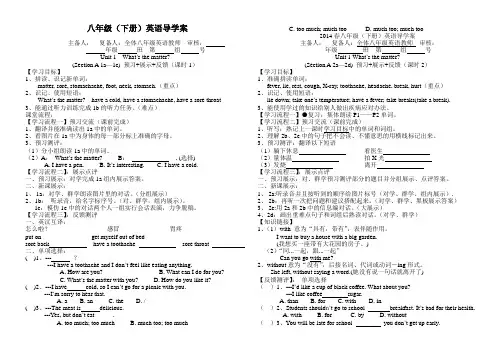
八年级(下册)英语导学案主备人: 复备人:全体八年级英语教师 审核: 年级 班 第 组 号 Unit 1 What ’s the matter? (Section A 1a —1c) 预习+展示+反馈(课时1) 【学习目标】 1、拼读、识记新单词: matter, sore, stomachache, foot, neck, stomach.(重点) 2、识记、使用短语: What ’s the matter? have a cold, have a stomachache, have a sore throat 3、能通过听力训练完成1b 的听力任务。
(难点) 课堂流程: 【学习流程一】预习交流(课前完成) 1、翻译并能准确读出1a 中的单词。
2、看图片在1a 中为身体的每一部分标上准确的字母。
3、预习测评: (1)分小组朗读1a 中的单词。
(2)A : What ’s the matter? B : . (选择) A. I have a pen. B. It ’s interesting. C. I have a cold. 【学习流程二】:展示点评 一、预习展示:对学完成1a 组内展示答案。
二、新课展示: 1、 1a :对学、群学朗读图片里的对话。
(分组展示) 2、1b : 听录音,给名字标序号。
(对、群学,组内展示)。
1c :模仿1c 中的对话两个人一组实行会话表演,力争脱稿。
【学习流程三】:反馈测评C. too much; much tooD. much too; much too2014春八年级(下册)英语导学案主备人: 复备人:全体八年级英语教师 审核:年级 班 第 组 号Unit 1 What ’s the matter?(Section A 2a —2d) 预习+展示+反馈(课时2)【学习目标】 1、准确拼读单词:fever, lie, rest, cough, X-ray, toothache, headache, break, hurt (重点) 2、识记、使用短语:lie down; take one ’s temperature; have a fever; take breaks(take a break). 3、能使用学过的知识给别人做出疾病应对办法。
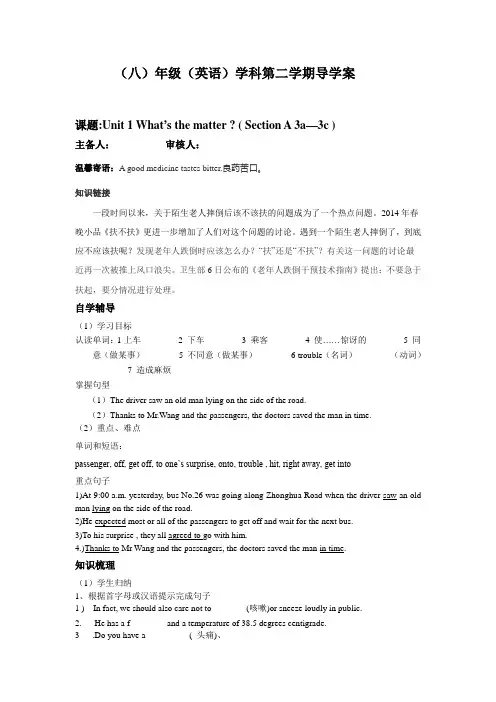
(八)年级(英语)学科第二学期导学案课题:Unit 1 What’s the matter ? ( Section A 3a—3c )主备人:审核人:温馨寄语:A good medicine tastes bitter.良药苦口。
知识链接一段时间以来,关于陌生老人摔倒后该不该扶的问题成为了一个热点问题。
2014年春晚小品《扶不扶》更进一步增加了人们对这个问题的讨论。
遇到一个陌生老人摔倒了,到底应不应该扶呢?发现老年人跌倒时应该怎么办?“扶”还是“不扶”?有关这一问题的讨论最近再一次被推上风口浪尖。
卫生部6日公布的《老年人跌倒干预技术指南》提出:不要急于扶起,要分情况进行处理。
自学辅导(1)学习目标认读单词:1上车________ 2 下车________ 3 乘客________ 4 使……惊讶的________ 5 同意(做某事)________5 不同意(做某事)________6 trouble(名词)________(动词)________7 造成麻烦________掌握句型(1)The driver saw an old man lying on the side of the road.(2)Thanks to Mr.Wang and the passengers, the doctors saved the man in time.(2)重点、难点单词和短语:passenger, off, get off, to one’s surprise, onto, trouble , hit, right away, get into重点句子1)At 9:00 a.m. yesterday, bus No.26 was going along Zhonghua Road when the driver saw an old man lying on the side of the road.2)He expected most or all of the passengers to get off and wait for the next bus.3)To his surprise , they all agreed to go with him.4.)Thanks to Mr Wang and the passengers, the doctors saved the man in time.知识梳理(1)学生归纳1、根据首字母或汉语提示完成句子1 ) In fact, we should also care not to _______ (咳嗽)or sneeze loudly in public.2. He has a f________ and a temperature of 38.5 degrees centigrade.3 .Do you have a _________ ( 头痛)、4. She wears a gold chain around her n_______ .5. There’s something wrong with my __________ (胃)6 . Tell me about your _______ ( 烦恼)。
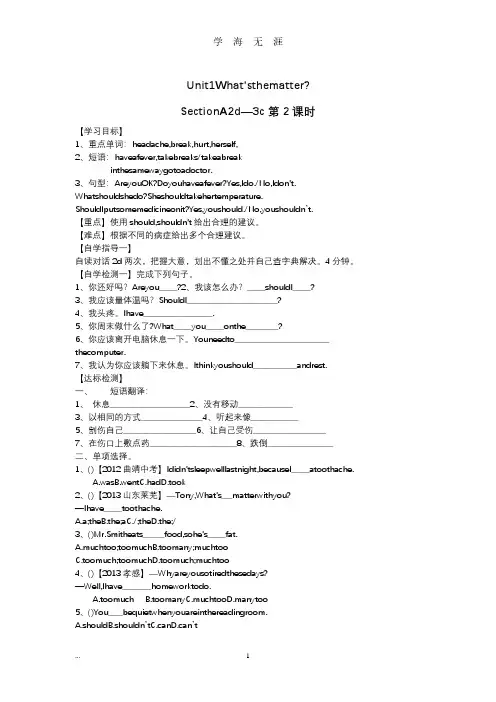
Unit1What’sthematter?SectionA2d—3c 第2课时【学习目标】1、重点单词:headache,break,hurt,herself,2、短语:haveafever,takebreaks/takeabreakinthesamewaygotoadoctor.3、句型:AreyouOK?Doyouhaveafever?Yes,Ido./No,Idon’t. Whatshouldshedo?Sheshouldtakehertemperature. ShouldIputsomemedicineonit?Yes,youshould./No,youshouldn’t.【重点】使用should,shouldn’t给出合理的建议。
【难点】根据不同的病症给出多个合理建议。
【自学指导一】自读对话2d两次,把握大意,划出不懂之处并自己查字典解决。
4分钟。
【自学检测一】完成下列句子。
1、你还好吗?Areyou_____?2、我该怎么办?_____shouldI_____?3、我应该量体温吗?ShouldI_________________________?4、我头疼。
Ihave___________________.5、你周末做什么了?What_____you_____onthe_________?6、你应该离开电脑休息一下。
Youneedto__________________________ thecomputer.7、我认为你应该躺下来休息。
Ithinkyoushould____________andrest.【达标检测】一、短语翻译:1、休息______________________2、没有移动_______________3、以相同的方式_________________4、听起来像_____________5、割伤自己____________________6、让自己受伤____________________7、在伤口上敷点药________________________8、跌倒__________________二、单项选择。
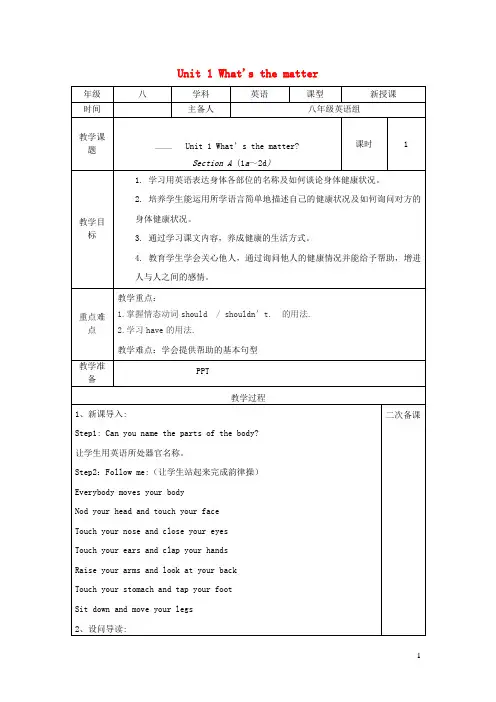
Unit 1 What's the matter年级八学科英语课型新授课时间主备人八年级英语组教学课题Unit 1 What’s the matter?Section A (1a~2d)课时 1教学目标1. 学习用英语表达身体各部位的名称及如何谈论身体健康状况。
2. 培养学生能运用所学语言简单地描述自己的健康状况及如何询问对方的身体健康状况。
3. 通过学习课文内容,养成健康的生活方式。
4. 教育学生学会关心他人,通过询问他人的健康情况并能给予帮助,增进人与人之间的感情。
重点难点教学重点:1.掌握情态动词should / shouldn’t.的用法.2.学习have的用法.教学难点:学会提供帮助的基本句型教学准备PPT教学过程1、新课导入:Step1: Can you name the parts of the body?让学生用英语所处器官名称。
Step2:Follow me:(让学生站起来完成韵律操)Everybody moves your bodyNod your head and touch your faceTouch your nose and close your eyesTouch your ears and clap your handsRaise your arms and look at your backTouch your stomach and tap your footSit down and move your legs2、设问导读:二次备课4. 如果你的头和脖子明天仍然疼的话,请去看医生。
五.拓展探究Homework: Make up a conversation between a doctor and a patient.课堂小结本课通过身体器官韵律操导入课时内容,激发学生的学习兴趣,提高课堂教学的效率,同时针对学生日常生活中的常见症状,让学生在列举过程中掌握患病方式的三种表达方式。
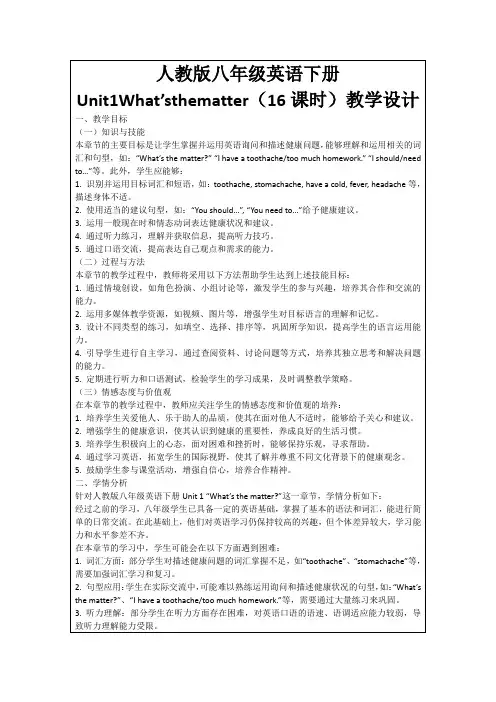

(八)年级(英语)学科第二学期导学案课题:Unit 1 What’s the matter ? ( Section B2a—3b & Self Check)主备人:审核人:温馨寄语:Great hopes make great man. (伟大的理想造就伟大的人。
)知识链接2003年5月美国登山爱好者阿伦·拉斯顿在犹他州一座峡谷攀岩时,因右臂被石头压住被困5天5夜,为了逃生,他强忍剧痛,花了一个多小时的时间,先后将桡骨和尺骨折断,用自己的运动短裤当作临时止血带,然后用小刀从肘部将右前臂硬生生切断。
从岩石下脱身后,为了与失血抢时间,他以超人的毅力爬过狭窄和风力强劲的峡谷,缘绳下到60英尺深的谷底,再步行5英里后与营救人员相遇,终于成功生还。
后拍成电影《127小时》自学辅导(1)学习目标学会使用本课的词汇和句子,熟练运用所学复述3a,提高学生的阅读与写作能力。
本节教学目标:认读单词:1 breathing()________ (动词) ________,2习惯于做某事____________ ,3 危险____,4 冒险________,5 用尽________(同意词组)________,6小刀(单数)________(复数)________,7切除________,8离开,从…出来,下车________,9掌管,管理________(反义词组)________10 …的重要性________ ,11决定(动词)________(名词)________ ,12死亡(动词)________(名词)________(形容词)________,13 keep on doing sth________,14 放弃(做某事)________(同意词组)________,15 nurse(名词)________(动词)________掌握句型:1 As a mountain climber, Aron is used to taking risks.2 Aron’s arm was caug ht under a 2,000-kilo rock that fell on him when he was climbing byhimself in the mountains.3 When his water ran out, he knew that he would have to do something to save his own life.4 After losing his arm, he wrote a book called Between a Rock and a Hard Place.5 With his left arm, he bandaged himself so that he would not lose too much blood.6 His love for mountain climbing is so great that he kept on climbing mountains even after thisexperience.(2)重点、难点1 Aron Ralston is an American man who is interested in mountain climbing2.On April 26,2003, he found himself in a very dangerous situation when climbing in Utah.3 He was not ready to die that day.4.Then, with his left arm, he bandaged himself so that he would not lose too much blood.5.His love for mountain climbing is so great that he kept on climbing mountains even after this experience.6 After losing his arm, he wrote a book called Between a Rock and a Hard Place知识梳理(1)学生归纳Task1小组共同学习2a ,2b新单词及有用短语1呼吸困难___________________________2 一个对爬山感兴趣的美国人____________3作为一名登山员_____________________4最令人兴奋的一件事__________________5丧生________________________6目的是________________________7一本叫《在岩石与险境间》的书________8处于很危险的境地____________________9他自己_______________________10习惯于做某事_______________________11一块2000千克的岩石____________12晒伤_______________________13 意味着生与死_______________________14讲述_______________________Task2 Underlined the words in 2b you don’t know,then loo k up the words in a dictory.Task3 Read the text then check the questions in 2c .Task4 Read the passage again and answer the questions in 2d.Task5 Put the sentences in the correct order in 2e. Then tell the story to your partner.Task6 Talk about the acciednt or a health problem in 3a. What should they do ?or What shouldn’t they do?Task7 自主学习并完成Selfcheck 1。
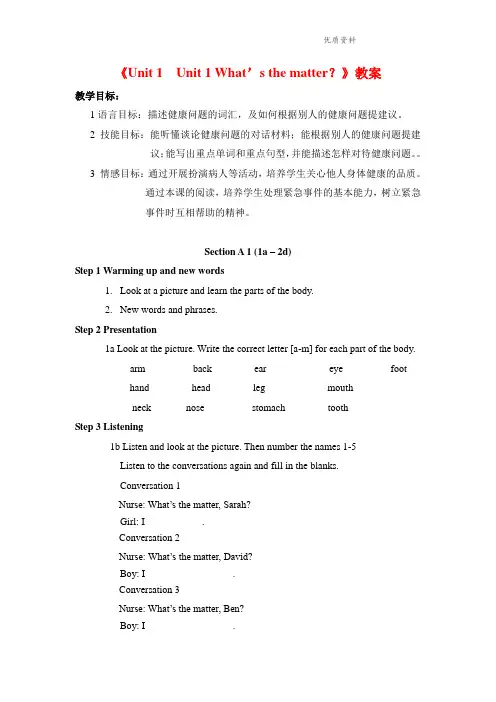
《Unit 1 Unit 1 What’s the matter?》教案教学目标:1语言目标:描述健康问题的词汇,及如何根据别人的健康问题提建议。
2 技能目标:能听懂谈论健康问题的对话材料;能根据别人的健康问题提建议;能写出重点单词和重点句型,并能描述怎样对待健康问题。
3 情感目标:通过开展扮演病人等活动,培养学生关心他人身体健康的品质。
通过本课的阅读,培养学生处理紧急事件的基本能力,树立紧急事件时互相帮助的精神。
Section A 1 (1a – 2d)Step 1 Warming up and new words1.Look at a picture and learn the parts of the body.2.New words and phrases.Step 2 Presentation1a Look at the picture. Write the correct letter [a-m] for each part of the body.___arm ___ back ___ ear ___ eye ___ foot___hand ___ head ___ leg ___ mouth___ neck ___nose ___ stomach ___ toothStep 3 Listening1b Listen and look at the picture. Then number the names 1-5Listen to the conversations again and fill in the blanks.Conversation 1Nurse: What’s the matter, Sarah?Girl: I ___________.Conversation 2Nurse: What’s the matter, David?Boy: I _________________.Conversation 3Nurse: What’s the matter, Ben?Boy: I _________________.Conversation 4Nurse: What’s the matter, Nancy?Girl: I _________________.Conversation 5Betty: What’s the matter, Judy?Ann: She __________________.Step 4 Speaking1c Look at the pictures. What are the students’ problems? Make conversati ons.ExamplesA: What’s the matter with Judy?B: She talked too much yesterday and didn’t drink enough water.She has a very sore throat now.A: What’s the matter with Sarah?B: She didn’t take care of herself on the weekend. She was p laying withher friends at the park yesterday. Then it got windy, but she didn’t puton her jacket. Now she has a cold.Step 5 Guessing gamesGuess what has happened to the students by using the important sentenc es. Step 6 Listening2a Listen and number the pictures [1-5] in the order you hear them.2b Listen again. Match the problems with the advice.Step 7 Speaking2c Make conversations using the information in 2a and 2bA: What’s the matter?B: My head feels very hot.A: Maybe you have a fever.B: What should I do?A: You should take your temperature.Step 8 Role–playImagine you are the school doctor. A few students have health problems.Role-play a conversation between the doctor and the students.2d Role –play the conversationStep 9 Language points and summary1. What’s the matter?这是人们特别是医生和护士询问病人病情时最常用的问句, 意思是“怎么了?”其后通常与介词with连用。
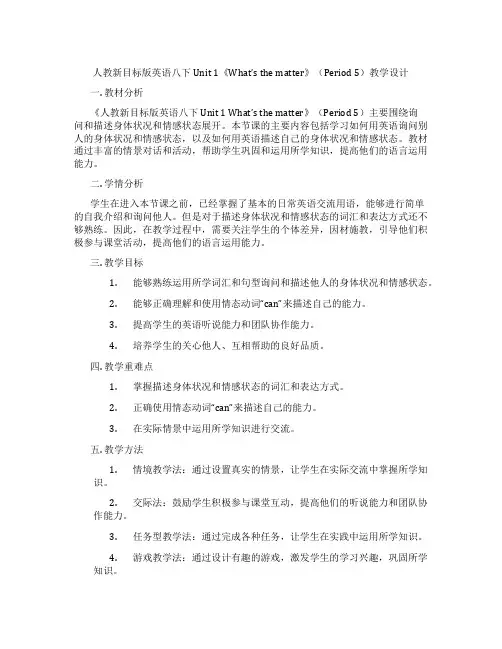
人教新目标版英语八下Unit 1《What’s the matter》(Period 5)教学设计一. 教材分析《人教新目标版英语八下Unit 1 What’s the matter》(Period 5)主要围绕询问和描述身体状况和情感状态展开。
本节课的主要内容包括学习如何用英语询问别人的身体状况和情感状态,以及如何用英语描述自己的身体状况和情感状态。
教材通过丰富的情景对话和活动,帮助学生巩固和运用所学知识,提高他们的语言运用能力。
二. 学情分析学生在进入本节课之前,已经掌握了基本的日常英语交流用语,能够进行简单的自我介绍和询问他人。
但是对于描述身体状况和情感状态的词汇和表达方式还不够熟练。
因此,在教学过程中,需要关注学生的个体差异,因材施教,引导他们积极参与课堂活动,提高他们的语言运用能力。
三. 教学目标1.能够熟练运用所学词汇和句型询问和描述他人的身体状况和情感状态。
2.能够正确理解和使用情态动词“can”来描述自己的能力。
3.提高学生的英语听说能力和团队协作能力。
4.培养学生的关心他人、互相帮助的良好品质。
四. 教学重难点1.掌握描述身体状况和情感状态的词汇和表达方式。
2.正确使用情态动词“can”来描述自己的能力。
3.在实际情景中运用所学知识进行交流。
五. 教学方法1.情境教学法:通过设置真实的情景,让学生在实际交流中掌握所学知识。
2.交际法:鼓励学生积极参与课堂互动,提高他们的听说能力和团队协作能力。
3.任务型教学法:通过完成各种任务,让学生在实践中运用所学知识。
4.游戏教学法:通过设计有趣的游戏,激发学生的学习兴趣,巩固所学知识。
六. 教学准备1.准备相关的图片、卡片、道具等教学辅助材料。
2.设计好各种教学活动和文化背景知识介绍。
3.准备好多媒体教学设备,如投影仪、电脑等。
七. 教学过程1.导入(5分钟)通过播放一段关于人物情感状态和身体状况的短片,引导学生关注本节课的主题。
教师提问:“Can you guess what’s the matter with the characters in the video?”,让学生发表自己的看法。
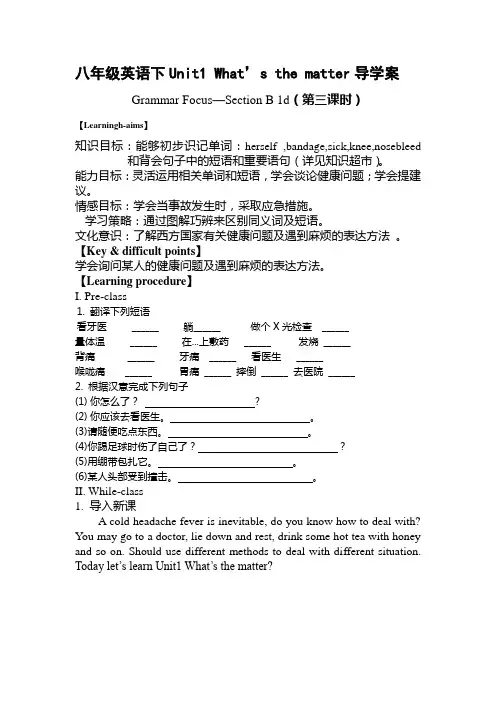
八年级英语下Unit1 What’s the matter导学案Grammar Focus—Section B 1d(第三课时)【Learningh-aims】知识目标:能够初步识记单词:herself ,bandage,sick,knee,nosebleed 和背会句子中的短语和重要语句(详见知识超市)。
能力目标:灵活运用相关单词和短语,学会谈论健康问题;学会提建议。
情感目标:学会当事故发生时,采取应急措施。
学习策略:通过图解巧辨来区别同义词及短语。
文化意识:了解西方国家有关健康问题及遇到麻烦的表达方法。
【Key & difficult points】学会询问某人的健康问题及遇到麻烦的表达方法。
【Learning procedure】I. Pre-class1. 翻译下列短语看牙医 ______ 躺______做个X光检查 ______量体温 ______ 在...上敷药 ______发烧 ______背痛 ______ 牙痛 ______看医生 ______喉咙痛 ______胃痛 ______ 摔倒 ______ 去医院 ______2. 根据汉意完成下列句子(1)你怎么了? ?(2)你应该去看医生。
(3)请随便吃点东西。
(4)你踢足球时伤了自己了??(5)用绷带包扎它。
(6)某人头部受到撞击。
II. While-class1. 导入新课A cold headache fever is inevitable, do you know how to deal with? You may go to a doctor, lie down and rest, drink some hot tea with honey and so on. Should use different methods to deal with different situation. Today let’s learn Unit1 What’s the matter?2. Learning the new knowledge:(1)掌握Grammar Focus(2)完成4a,4b(3)活动One student mimes a problem. The other students in your group guess the problem and giveadvice.A: Wh at’s the matter? Did you hurt yourself playing soccer?B: No, I didn’t.C: Did you fall down?B: Yes, I did.D: You should go home and get some rest.(4)合作完成Section B(1a),讲解句子中的知识点,学会事故发生时如何处理的表达方法。
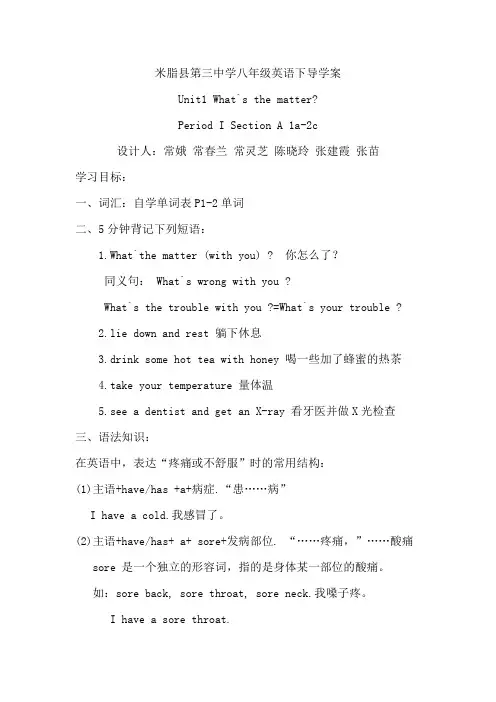
米脂县第三中学八年级英语下导学案Unit1 What`s the matter?Period I Section A 1a-2c设计人:常娥常春兰常灵芝陈晓玲张建霞张苗学习目标:一、词汇:自学单词表P1-2单词二、5分钟背记下列短语:1.What`the matter (with you) ? 你怎么了?同义句: What`s wrong with you ?What`s the trouble with you ?=What`s your trouble ?2.lie down and rest 躺下休息3.drink some hot tea with honey 喝一些加了蜂蜜的热茶4.take your temperature 量体温5.see a dentist and get an X-ray 看牙医并做X光检查三、语法知识:在英语中,表达“疼痛或不舒服”时的常用结构:(1)主语+have/has +a+病症.“患……病”I have a cold.我感冒了。
(2)主语+have/has+ a+ sore+发病部位. “……疼痛,”……酸痛sore 是一个独立的形容词,指的是身体某一部位的酸痛。
如:sore back, sore throat, sore neck.我嗓子疼。
I have a sore throat.(3)主语+have/has +a+身体某部位-ache-ache作后缀,常与表示身体部位的名词合成一个新词,表身体某部位疼痛,如:toothache , headache , stomachache ,backache, earache.He has a headache. 他头疼。
(4)(There is)something wrong with +one`s+身体某部位某人某部位不舒服/出了毛病。
There is something wrong with my leg.我的腿有点问题。
Unit1What’sthematter?SectionA2d—3c 第2课时【学习目标】1、重点单词:headache,break,hurt,herself,2、短语:haveafever,takebreaks/takeabreakinthesamewaygotoadoctor.3、句型:AreyouOK?Doyouhaveafever?Yes,Ido./No,Idon’t. Whatshouldshedo?Sheshouldtakehertemperature. ShouldIputsomemedicineonit?Yes,youshould./No,youshouldn’t.【重点】使用should,shouldn’t给出合理的建议。
【难点】根据不同的病症给出多个合理建议。
【自学指导一】自读对话2d两次,把握大意,划出不懂之处并自己查字典解决。
4分钟。
【自学检测一】完成下列句子。
1、你还好吗?Areyou_____?2、我该怎么办?_____shouldI_____?3、我应该量体温吗?ShouldI_________________________?4、我头疼。
Ihave___________________.5、你周末做什么了?What_____you_____onthe_________?6、你应该离开电脑休息一下。
Youneedto__________________________ thecomputer.7、我认为你应该躺下来休息。
Ithinkyoushould____________andrest.【达标检测】一、短语翻译:1、休息______________________2、没有移动_______________3、以相同的方式_________________4、听起来像_____________5、割伤自己____________________6、让自己受伤____________________7、在伤口上敷点药________________________8、跌倒__________________二、单项选择。
新目标八年级下Unit1 What’s the matter?Period1(sectionA)第一课时一、[教材分析]本单元的话题是健康问题,健康是一切活动的保障,本节课的话题出自Unit1 What’s the matter?(sectionA),主要让学生认知表示身体部位的单词以及部分疾病的表达方法,学会谈论自己及他人的健康状况,能针对健康问题提出合理化建议。
在具体教学中我对教材内容进行了整合,删除了材料中的听力部分,将其用图片的形式展示出来以保持课堂的完整性。
我还对教材做了适当的修改和扩充,使内容更贴近生活,让学生有更多的发挥空间。
二、[学情分析]八年级的学生具有过渡性和动荡性的心理特点,处于两极分化的突出时候,学生差异较大,因此在任务设计上我注重分层,面向全体,充分调动每个学生的积极性。
但由于这个阶段的学生活泼好动,好奇心较强,再加上本节课又是他们从未接触过的有关健康的话题,所以在课堂设计上我十分注意生动活泼但不幼稚,发扬传统但不古板。
三、[教学目标分析]1、Knowledge Objectives(知识目标)(1) Be able to master the pronunciation,meaning and spelling of the names of body parts and diseases.(2) Be able to learn the expressions of giving advice.(3) Be able to talk about health problems by using “What’s the matter? I have a……” and give advice by using “You should ……You shouldn’t……”2、Ability Objectives(能力目标)(1) Be able to talk about one’s health problems and give advice fluently(2) Be able to role play doctor and patient3、Moral Objectives(情感态度目标)(1) Improve the cooperative spirit through pair work and role playing(2) Care more about yourself and others’ health四、[重难点设计]由于本节课的话题是谈论健康,根据课标要求,学生需掌握有关疾病的单词,并能针对疾病提出合理化建议,因此本节课的教学重点设计如下:The teaching focus:1、Master the names of diseases.2、Master the expressions of giving advice3、Talk about health problems by using “What’s the matter? I have a……” and give advice by using “You should ……You shouldn’t……”本节课的话题学生以前接触较少,知识储量有限,让他们在较短的时间内掌握较多的新单词有一定难度,再者,由于学生生活经验的限制,在谈论如何给出合适建议时会出现一定的困难。
班级:姓名:____________Unit 1 What’s the matter?Section A(1a—2d)第一课时主备人:王*庆【学习目标】知识目标:掌握本节的生词和句型。
能力目标:能够听懂医生和病人之间的对话。
知识目标:掌握本节的生词和部分重点句型。
---What’s the matter? ---I have a stomachache.---What’s the matter with you? ---I cut myself.能力目标:能模仿医生和病人之间的对话。
知识目标:掌握本节的生词和重点句型。
---What’s the matter? ---I have a toothache.---What should I do? ---You should drink some hot tea with honey.能力目标:能够扮演医生或者病人的角色进行语言演练。
【课前热身】任务一:请写出下面的身体部位名词胳膊___ 耳朵___ 后背___ 眼睛___ 脚___ 手___ 头___腿_____ 嘴巴___ 脖子_____ 鼻子_____ 胃部_____ 牙齿_____任务二:1. have a toothache2. have a stomachache3. have a backache4. have a headache5. h ave a sore throat6. have a fever7. have a cold 8. lie down and rest9. drink hot tea with honey 10. drink lots of water11. see a dentist 12. take one’s temperature13. go to a doctor你怎么了?我头疼/胃疼/牙疼。
________________? _____________________.【听课疑问】(请同学将听课中自己的问题和不清楚的地方及时记在导学案上)问题1:问题2:【教师答疑】【当堂检测】I.根据句意及汉语提示写出所缺的单词1.Lisa didn't go to school because she had a ________ (头痛).2.3.The man had a ________ (咳嗽) last night, so he didn't sleep well.4.I'm not feeling well. I have a ________ (胃痛).5.hen you have a ________(发烧), you should go to a doctor.6.Go and ________ (躺) down for a while.II.用括号内的适当形式填空。
Unit 1 What’s the matter?(1)【学习目标】:知识与技能:1. 能听说读写重点单词和词组:matter, sore, have a cold, stomachache, have a stomachache, foot, neck, stomach, throat, fever, lie, lie down, rest, cough, X-ray, toothache, take one’s temperature,see a dentist2.句型:学会用What’s the matter? I have a cold. I have a stomachache. I have a sore back. I have a sore throat. 谈论身体情况。
3. 学习用should 给出建议过程与方法:向学生展示图片,同时播放录音,让学生努力地听,理解大意;采用学生模仿录音读,并和老师合作对话练习,学生之间对话练习;情感态度与价值观:通过谈论身体状况给出同学相应的建议,可以使同学之间的情谊加深。
【学习重点】:能询问并表述身体的种种不适以及对他人身体的种种不适给予适当的建议。
【学习难点】:用should 给出建议,使用情态动词。
【学法指导】:“组织课堂——复习——导入新课——讲授新知识——操练巩固”来开展教学预习交流把你所知道的身体部位的单词写下来,并写出其相应的中文意思。
eye眼睛_______ ______ ______ ______ ______ ____________ ______ ______ ______ ______ ______ ______ ____________ ______ ______ ______ ______ ______ ______ ____________ ______ ______ ______ ______ ______ ______ ______【合作探究]1、What’s the matter?怎么了,其后常与介词with 连用。
班级:组名:姓名:日期:2014/2/17 编制:八年级英语备课组课题: Unit1 What’s the matter? 课时:第2课时【学习目标】学习内容:Section 3a—4c学习目标:1、掌握Page3-4的单词和短语。
2、通过合作探究,继续巩固和运用下列谈论健康状况、给出合理化建议及祝福的重点句型:What's the matter?I have a sore throat.You should go to bed.You shouldn't eat anything.I'm not fe eling well.That's too bad.I think so.I hope you feel better soon.3、全力以赴,高效学习。
学习重点:1、本节课应掌握的生词和短语。
2、熟练掌握和运用学习目标中所要求的重点句型。
学习难点:运用所学知识进行综合运用。
能力立意:培养学生正确处理身体健康问题的生活能力。
自学指导:1、自学Page3-4的单词。
(根据音标拼读、拼写单词并牢记)。
2、学生自学语法要点,归纳出重点内容。
3、标出重要的短语和句型,标出疑难点,准备课堂中讨论解决。
【定向导学·互动展示·当堂反馈】正课:1、课前检查(5)2、合作探究(28)3、学以致用(10)4、课堂小结(2)学习流程【探究·展示·反馈】随堂笔记【成果记录、知识生成、规律总结】一、自学检测:(A.B.C层必做)根据句意或首字母提示填空:1.I had a bad fever two days a_____.2.It's raining heavily outside,there are s___ much water on the playground.3.When somebody has some illness,you should give him or her some a____.翻译下列短语和句子给某人一些建议__________ 两个月以前______________三周以前_________________ 一个好主意________________我想如此________________我感到不舒服________________我希望你尽快好起来____________________________二、合作探究:1、组内讨论解决自学检测中的疑难问题。
Unit1 What’s the matter?第一课时Section A 1a—2d【Study-aims】知识目标:1. 掌握人体部位及身体症状的单词。
2. 掌握下列句型--- What’s the matter (with you)?---I have a …--- What’s the matter with her/him? ---She/He has a…You should …. You shouldn’t ….能力目标:学会询问他人病情,会填写病历表并提出相应的建议。
情感目标:主动去救助处于危险境地的人,在生死抉择之际,要有勇气做出正确的决定。
学习策略:综合培养学生与别人交流和沟通的能力。
文化意识:让学生更多的了解中西方的就医、关心、建议的表达及公德意识的培养。
【Key & difficult points】询问某人的健康问题及遇到麻烦的表达方法。
情态动词should的用法。
【Learning procedure】I. Pre-class1. 翻译下列短语1) 感冒2) 胃疼3) 喉咙痛4) 躺下5) 加有蜂蜜的热茶6) 头疼7) 量体温8) 躺下休息9) 看牙医10)做一个X光检查11) 割伤自己12) 发烧13) 整个周末14)去看医生2. 知识超市:1) matter为可数名词,意为“毛病;麻烦事”,通常用于句型What’s the matter (with sb)?中。
该问句常用来询问某人患了何种疾病或遇到了何种麻烦。
Eg: ——What’s the matter with him?他怎么了?——He has a headache. 他头痛。
matter还可作不及物动词,意为“要紧;有关系”Eg: It does n’t matter. 没有关系2. Learning the new knowledge(1)学会谈论询问某人的健康问题及遇到麻烦的表达方法。
2) I have a cold. 我感冒了。
此处have 为及物动词,意为“患(病);遭受(病痛)”have a cold 意为“患感冒”。
此处cold为可数名词,意为“感冒,伤风”。
Eg: He had a bad cold last week.他上个星期患了重感冒。
cold作不可数名词,意为“冷,寒冷”,Eg: Don’t stan d outside in the cold.不要站在外面寒冷的地方。
cold还可作形容词,意为“冷的,寒冷的”。
Eg: It’s very cold today, 今天很冷。
3) I think you should lie down and rest.我认为你应该躺下休息。
①lie (lay, lying)此处为不及物动词,意为“躺;卧”。
Eg: Don’t lie in bed all morning.不要一上午都躺在床上。
② lie作不及物动词,意为“撒谎;说谎”,过去式和过去分词均为lied,现在分词为lying. Eg: You are lying to me. 你在对我撒谎。
③ lay动词,意为“产(卵);下蛋”,过去式和过去分词均为laidEg: The hens are not laying well at the moment.现在那些鸡不爱下蛋。
4)词语辨析sore, ache① sore, ache都可以表示身体疼痛,sore为形容词,后接表示身体部位的名词。
Eg: have a sore throat喉咙痛have a sore back 背痛② ache作名词时,常作后缀,与表示身体部位的名词连用,如:headache5)rest 放松休息①动词放松休息Eg: You should rest for a few days.②名词等于breakhave/take a rest=have /take a break6)复习advice need和enough的用法5. 复习提问关于身体部位的名词II. While-class1.导入新课(活动:Work in pairs)(2)利用多媒体举一反三,引出What’s the matter with him/her,并提出自己的建议。
(活动:Work in groups)(3)听录音,完成1b、2a和2b.(4)分角色表演2d并背诵.3. 当堂检测:1) 根据句意及首字母提示完成单词。
①. ---- What’s the m with Jenny?---- She has a cough and a headache.②.He’s very tired. He s lie down and rest.③.I can’t sleep well all the time. Can you give me some a.④.Most people work until they are 60 or 65 years old. Then they retired(退休) and have a lot of ftime.⑤ My sister has a f . She should be taken to the hospital.2)根据汉意完成句子。
① My brother doesn’t feel well. He must (休息).② Little boy, if you (牙疼), you should see a dentist.③ M y sister has a bad cold and she (高烧).④ This morning Mary ate something bad. So she (胃疼).⑤ Jim (喉咙疼), so he must drink water and must have a good rest.4. 小结:III. Post-class1.编一个询问病情并给出建议的对话。
2.收获与反思。
【Blackboard Design】Unit1 What’s the matter?What’s the matter?soreI have a cold / headache / toothache ache/ fever /sore throat.You should/shouldn’t…My … hurts.Unit1 What’s the matter?第二课时Section A 3a—3c【Study-aims】知识目标:掌握本课的9个新单词。
能力目标:用推理判断法去解阅读理解题。
情感目标:通过学习应学会主动救人,救人不容考虑的社会价值观。
学习策略:通过复述课文去掌握重要语言点。
文化意识:要主动去救助别人,人人都献出一点爱,我们的社会将变成美好的人间。
【Key & difficult points】用推理法去解阅读理解题。
【Learning procedure】I. Pre-class1. 翻译下列短语下车希望某人做某事使某人感到惊讶的是同意做某事2. 知识超市:⑴get off 下车动副结构⑵happen 发生something happens to somebody……发生在…….身上碰巧happen to do something 碰巧做某事⑶to one’s surprise 使某人感到惊讶的是⑷agree to do something 同意做某事⑸thanks to 多亏……II. While-class1. 导入新课When someone is in trouble, what do you usually do? Do you go at once as if it didn’t happen or help him/her without thinking? Now, next please read the passage and see what the driver and passengers did?2. Learning the new knowledge:⑴读文章,完成3b。
⑵讲解文章所及知识点。
⑶小组讨论3c。
3. 当堂检测:⑴根据句意写单词3.The bus must n’t carry too many .②That’s a good idea. I with you.⑵用所给词的适当形式填空①He saw a wallet (lie) on the ground on his way to school.②We can’t visit others without (call) first.③To his (surprise),we were still waiting for him.④The doctor saved many people’s (life).⑤ The teacher told us (not play)in the street.4. 小结:Ⅲ. Post-class1 掌握本课的9个新单词。
2 复述并会默写3a。
3 完成大本文曲星Unit1 SectionA。
4 收获与反思:【Blackboard Design】Unit 1 What’s the matter? Notes: Review:1 was going 1身体各部位单词2 see A doing 2 ……怎么了3 next to4 think aboutUnit1 What’s the matter?第三课时Grammar Focus—Section B 1d【Study-aims】知识目标:能够初步识记单词:herself ,bandage,sick,knee,nosebleed和背会句子中的短语和重要语句(详见知识超市)。
能力目标:灵活运用相关单词和短语,学会谈论健康问题;学会提建议。
情感目标:学会当事故发生时,采取应急措施。
学习策略:通过图解巧辨来区别同义词及短语。
文化意识:了解西方国家有关健康问题及遇到麻烦的表达方法。
【Key & difficult points】学会询问某人的健康问题及遇到麻烦的表达方法。
【Learning procedure】I. Pre-class1. 翻译下列短语看牙医______躺下______做个X光检查______量体温______在...上敷药______发烧______背痛______牙痛______看医生______喉咙痛______胃痛______摔倒______去医院______2. 根据汉意完成下列句子(1) 你怎么了?II、知识超市:1、yourself为反身代词,意为“你自己,自己”。
其复数形式为yourselves,意为“你们自己”。